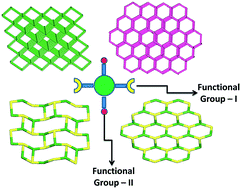Metalloligands to material: design strategies and network topologies
Abstract
This highlighted article discusses the design strategies involving the use of metalloligands as molecular building blocks for the construction of supramolecular architectures. In a coordination-driven approach, metalloligands are connected via the mediation of secondary metal ions to produce 1D, 2D, and 3D architectures. However, the metalloligands offering hydrogen-bonding-sensitive functional groups participate in the assembly of multi-dimensional networks purely manifested by the weaker yet directional intermolecular hydrogen bonds. Attempts have been made to generalize the design concept by invoking network topologies.



 Please wait while we load your content...
Please wait while we load your content...